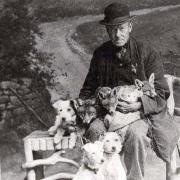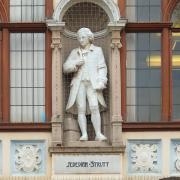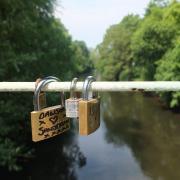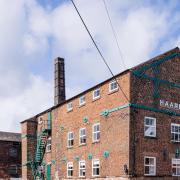Dr Gareth Williams, British Museum curator and expert on the history and archaeology of the Vikings and of Tutbury Castle, advised on a recent case concerning the illegal break-up of a Viking hoard of ‘national importance’. Pat Ashworth reports.

Coins are ‘very small texts’ for Dr Gareth Williams, curator of early medieval coins and Viking material at the British Museum. They are full of clues to the history of a particular period and he can read them like a book. A historian by profession, he says the joy of working in a museum as opposed to a university department is that you can share your knowledge with a much wider range of people – a passion for communication that he shares with his wife, Lesley Smith, curator of Tutbury Castle.
We’re at Tutbury on a winter’s day, with the rain falling and the ancient castle wreathed in mist. Dr Williams has come into prominence at this particular time in relation to the large Viking hoard of gold jewellery, a silver ingot and coins discovered by two amateur metal detectorists in Herefordshire in 2015. The finders, George Powell and Layton Davies, were convicted and jailed in November last year for failing to declare the find as the law demands; for attempting to sell items from the hoard – only 30 coins have been recovered, along with the jewellery – and for denying that they had secreted coins worth millions.
The hoard was hidden in all likelihood by a Viking warrior as his army retreated into the Anglo-Saxon kingdom of Mercia following the victory of Alfred the Great in the year 878. Such hoards were generally buried for safety and ‘because the Vikings did not always trust each other’, Dr Williams suggests. ‘Alliances could change and members of an army could later find themselves on the opposite side, so it was worth burying your wealth when you were encamped, even if it was just overnight.’
He cheerfully confesses to a mixture of huge excitement and ‘a bit of irritation’ when he learned of the hoard in that summer of 2015: excitement because initial reports suggested it was something very special, and irritation because he was working on a book about hoards and the last thing he wanted was another one which ‘could upset everything you have got straight in your head…’. It didn’t do that. What the coins did, he rejoices, was to establish a clear connection between two kings, Alfred the Great, King of Wessex from 871-879, and Ceolwulf II (874-879), one of the lesser known kings of the independent kingdom of Mercia.

Surviving narratives such as the Anglo-Saxon Chronicle have lauded Alfred’s exploits and given Ceolwulf a bad press, dismissing him as ‘a foolish king’s thane, a minor noble, a puppet of the Vikings,’ says Dr Williams. ‘Nothing is said anywhere about what became of him.’ But the coins prove that in Mercia at least he was recognised as a proper king, with control over an established area and the blessing of the Church. ‘There had been some tantalising hints from what coins we had previously that maybe there was more to this than met the eye. But up until now, the coinage didn’t survive in large enough quantities to give us a very clear picture,’ he observes.
That picture was about to change. Among the 30 coins recovered were five very rare ‘emperor coins’, the reverse of each depicting two emperors side by side. Three have Ceolwulf on the front; the remaining two depict Alfred. ‘The image of the emperors is copied from late Roman coin designers, so that’s not unusual. But they clearly had a lot of coins to choose from and a coin of that design is not likely to be coincidence,’ remarks Dr Williams. ‘They also struck their coins at a much better quality of silver than had gone before, so it looks like they’re sharing a design and carrying out a coin form together. This was followed by another coinage, no longer with the two emperors but again produced by the two kings together, with a variety of different busts suggesting they were being produced in a number of different places. And both of these are extremely rare. Until 2015, we had only one example in the name of Alfred and one in the name of Ceolwulf.’
A few months after the hoard was found, another from the same period was found near Waplington in Oxfordshire, containing two more of the emperor type and more of the others. ‘When that first turned up and we were aware of the large amount missing from the Herefordshire find, our first thought was that this could be the missing coins from the first hoard, reburied by the detectorists,’ Dr Williams remembers. But this proved not to be the case: the finder followed the correct procedures and kept this hoard safe until archaeologists were able to remove it for examination.
It has all put a new perspective on how Mercia and Wessex were ruled in the 9th century, at around the time England was evolving into a single united kingdom. The Vikings left Repton – burial place of the kings of Mercia, centre of a royal dynasty – in 878, and the settlement of one group in Yorkshire is the substance of the book Dr Williams has been working on since 2004, due for publication shortly. Other groups moved on to Wessex and further afield. Vikings were ‘way ahead in their planning, logistics and supplies, turning up in places at the beginning of winter when supplies had been stored, and controlling the food supply by moving their river-going fleets around,’ he suggests.

By 879, all written mention of Ceolwulf has disappeared, and by the 890s, when the Anglo-Saxon Chronicle is written – at Alfred’s court – Alfred is now in charge of most of Mercia as well – ‘and if there is anything positive they can say about him, they do,’ observes Dr Williams, adding, ‘You’d think acquiring a neighbouring kingdom was worth recording, so it suggests that maybe the circumstances in which he acquired it were not so positive… I’ve drawn parallels with Stalin airbrushing Trotsky out of the history of the Soviet Union.
‘By the time of the Chronicle, Alfred is promoting himself as King of the Anglo-Saxons, combining the kingdom of Wessex, a large part of Mercia, and Kent, which his grandfather had grabbed. It becomes the kingdom of England, with an interest in perpetuating that story – which we as historians have accepted rather uncritically ever since. Alfred’s achievements overall were good. But the coinage shows another chapter to this story: that Mercia was working alongside him and even took part in some of these victories; and that he seized the opportunity in a way that the most flattering of sources could give him credit for.’
He’d love to find another Mercian or independent manuscript that could shed further light on all this. And working as he has been lately on the coinage of Harold II, his dream would be the discovery of a hoard dating from just after the Battle of Hastings in 1066. ‘It would be great if we had a hoard with coins from Central Mercia, Derbyshire or Staffordshire, from around the time of the Staffordshire Hoard,’ he says. That hoard, the largest collection of Anglo-Saxon gold and silver treasure, was deposited in the 7th century.
‘Evidence suggests that Derbyshire, Nottinghamshire and Leicestershire were all under Viking control as well, but only a very small number of coins have survived and the sequences are not clear. Having such a hoard would help us understand the chronology and the relationship of individuals in the East Midlands at that period,’ he says.

It’s a very pleasing connection that the largest coin hoard ever found in this country was actually at Tutbury. Thousands of coins were discovered in the bed of the River Dove in 1832, when the flow of the river was being improved to supply a cotton mill. Estimates at the time put the number at 300,000, and the hoard dates from 1322, following the Battle of Burton Bridge. Three iron-bound barrels are known to have been taken to the Priory for safe keeping as Thomas of Lancaster retreated in the face of the oncoming army of Edward II. It’s not inconceivable, muses Dr Williams, that the barrels were rolled down the hill into the water, to be left there until things quietened down.
It’s evident that he loves solving a mystery. He has had a love of history ever since he was a small child taken to castles whilst on holiday; he credits his teacher at secondary school for engaging his classes so well, and he loved reading the historical fiction of children’s writers like Henry Treece and Rosemary Sutcliffe. He read ancient and medieval history at the University of St Andrew’s in Scotland, a first degree which led to a PhD on the Vikings and later, close involvement with the TV series, The Real Vikings.
He has been an expert at the British Museum for 23 years and has been familiar with Tutbury Castle for almost as long. For three weeks every year for four years, he was part of an archaeology team excavating the site, and jokes, ‘I came to dig up the Castle and dug up Lesley as well… It’s a wonderful thing, a real privilege, to be associated with a place like this. I always wanted a castle of my own and now I’ve got one, although I don’t own it and I share it with the Queen…’ – a reference to Lesley, famous for her stunning costumed portrayals of historical figures at Tutbury, especially of Elizabeth I.
For his part, Dr Williams can be found on occasions dressed as a Viking and inspiring schoolchildren with the history of the period. He concludes, ‘We both love sharing our love of history with others. It’s no use having all this knowledge if you don’t.’ And he confesses that there are still days when he comes here that the place ‘just catches me. It’s a beautiful place, full of atmosphere. It grabbed me when I first came up here, and it’s a pleasure to see other visitors coming here and being grabbed in the same way.’



























